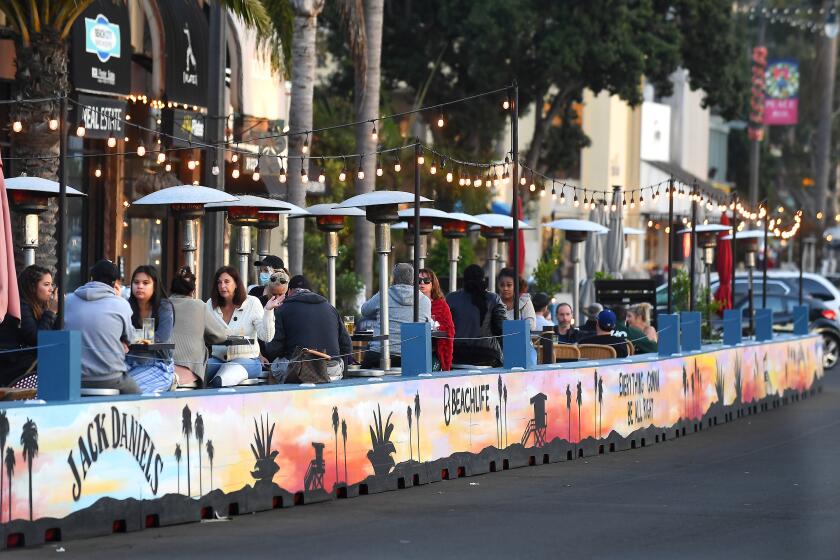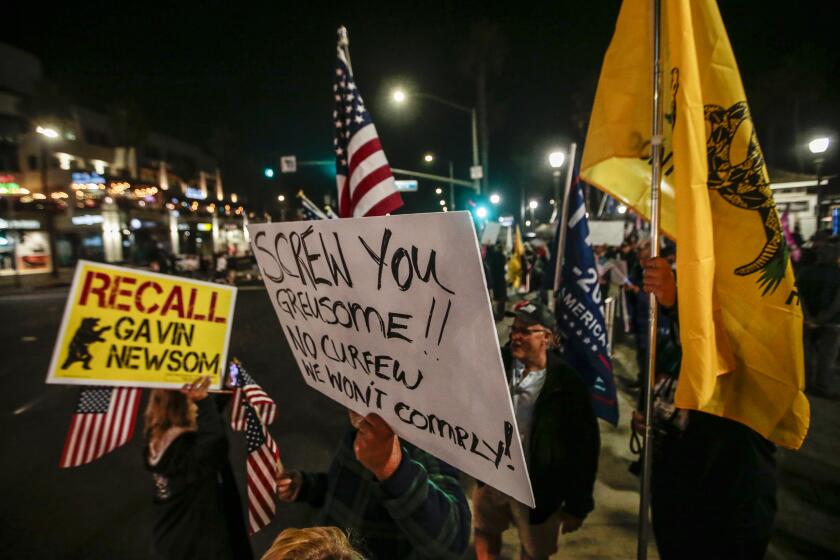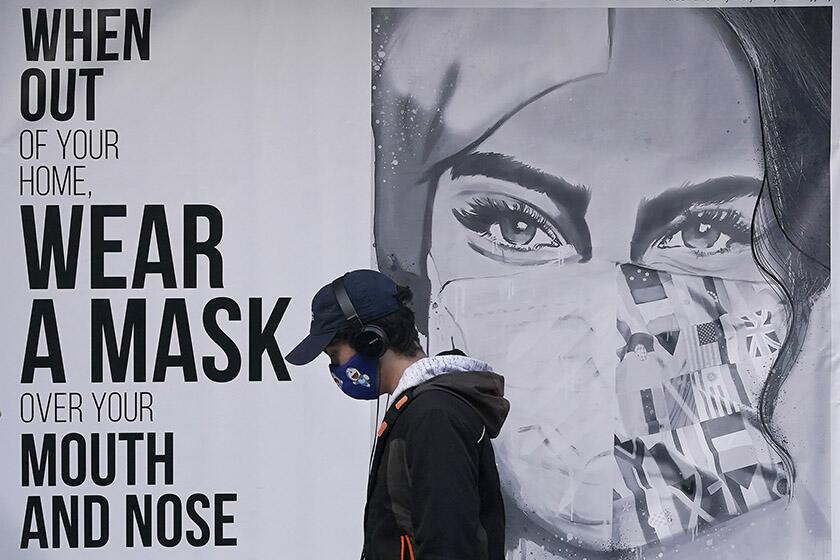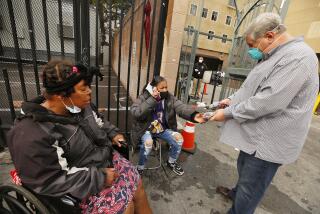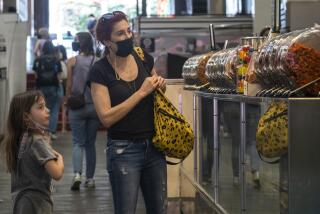New stay-home order looms for L.A. County as COVID-19 cases soar to new highs
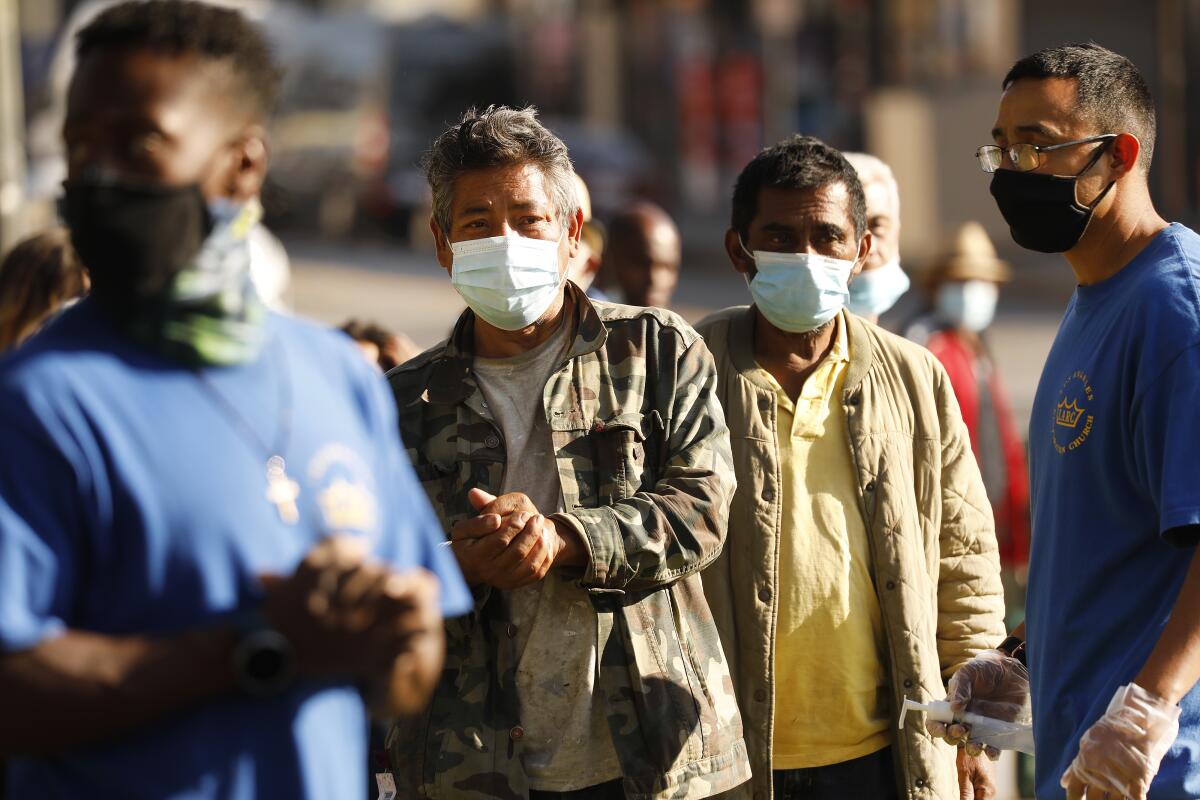
- Share via
The specter of another COVID-19 shutdown is looming over Los Angeles County, as a record-high number of daily coronavirus cases Monday pushed the region over its self-set threshold for issuing a new stay-at-home order.
The strong possibility of more restrictions comes as health officials and epidemiologists expressed increasing alarm at the unparalleled pace of increased cases in L.A. County and throughout the state. California is now on pace to see its cumulative death toll double just before spring, from the more than 18,700 deaths currently tallied to more than 37,000 by March 1, according to model forecasts by the University of Washington’s Institute for Health Metrics and Evaluation.
A Times analysis on Monday found that the average daily number of coronavirus cases over a five-day period has more than tripled since election day. COVID-19 hospitalizations have doubled since mid-October, from 730 on Oct. 18 to 1,473 on Sunday.
Both California and Los Angeles County shattered records for single day on Monday, with the state recording more than 20,000 coronavirus cases and Los Angeles County recording more than 6,100. The previous statewide single-day record came just a week earlier, when more than 13,400 cases were reported on Nov. 16, and in L.A. County, on Thursday, when nearly 5,000 cases were recorded.
“We’ve seen alarming steep increases in cases of COVID-19,” said the L.A. County director of public health, Barbara Ferrer.
The Los Angeles County total was inflated by roughly 1,500 that were part of a reporting backlog from Sunday, but Ferrer said “it’s still an impressive and alarming surge. Our problem right now is we have such a high rate of transmission, there are so many people that are infected at this point, that it will take a lot of work to get us back down.”
When such a new stay-at-home order will be handed down, or what precise form it will take, is unclear. But Ferrer said “for sure, we’re not going back to all of the restrictions that were in place in the original Safer at Home order.” The Board of Supervisors is scheduled to discuss the order at its Tuesday meeting.
As COVID spikes, hospitalizations are rising — and more L.A. County residents are dying at an increasingly rapid pace. A Times analysis found that the deaths of an average of 26 people were reported every day over a seven-day period, more than double the pace experienced on election day.
“We need to be examining all of our options and put all of the possible methods of control on the table,” said Dr. Robert Kim-Farley, medical epidemiologist and infectious diseases expert at the UCLA Fielding School of Public Health, and a former senior official with the L.A. County public health department and Centers for Disease Control and Prevention.
As a state, “we have runaway transmission and it mostly seems to be coming from metropolitan Southern California,” said Dr. George Rutherford, epidemiologist and infectious diseases expert at UC San Francisco. “You gotta get it under control.”
Gov. Gavin Newsom has announced a stay-at-home order affecting most of California.
At a certain point, if intensive care units max out at capacity and “all of a sudden you have one nurse taking care of seven patients on ventilators like in New York, mortality can be astronomical,” Rutherford said.
The actions taken this week will likely take two to three weeks to show up in changing daily case counts, and that’s why it’s plausible that daily infection numbers will continue to rise this week, Ferrer said.
With Monday’s numbers, the average number of new daily coronavirus cases over a five-day period hassurpassed 4,500, according to the county’s tally — cracking the threshold that would trigger a new three-week order that, as described last week, would generally permit only essential workers and those procuring essential services to leave their homes.
On Monday, however, Ferrer described a proposed new stay-at-home order that would be less encompassing than the one issued in March. It’s unnecessary to be as broad, she suggested, because officials know more about the virus and testing capacity has improved. The specifics will be discussed with the the supervisors, a five-person elected board that represents the 10.1 million residents of Los Angeles County.
“The question now that we’ll be working with the board on is exactly what additional measures need to be in there,” Ferrer said.
L.A. County public health officials on Saturday announced they will issue an order suspending outdoor dining at restaurants amid a surge of new coronavirus cases.
Such a move would be the latest, and most drastic, step the county has taken as it scrambles to get arms around its most significant coronavirus surge yet. Given the severity of the current spike, L.A. County residents are already being urged to stay home as much as possible over the next few weeks, and are being asked to cancel Thanksgiving travel plans, whether it be a flight or a drive across town.
Though there may be relief in the months ahead, given the recent promising news on vaccines, Ferrer said everyone needs to remain vigilant and do what’s necessary to protect themselves and their loved ones.
Amid pandemic fatigue, people are questioning the new California COVID-19 lockdown measures. Experts say these rules could help slow the infection rate.
Los Angeles Mayor Eric Garcetti expressed support for tougher stay-at-home orders.
“I’m not here to dance around this issue or to take, you know, half measures and watch people die,” Garcetti said. “ And what are we going to do? Wait ’til it gets to 10, 15, 20,000 cases [a day] and then suddenly say, ‘We’re shutting down,’ and now we’re shut down for two or three months?”
With the county’s daily number of coronavirus cases, averaged over a five-day period topping 4,000, officials are set to suspend outdoor dining starting at 10 p.m. Wednesday — delivering yet another blow to the region’s already battered restaurant industry. Takeout and delivery of restaurant food can continue.
That move sparked pushback from restaurants, who have been reeling from the pandemic. Outdoor dining had offered a lifeline, and many owners and workers felt they were doing everything they could to keep their establishment safe.
Supervisor Kathryn Barger also criticized the suspension of outdoor dining, saying it “will further devastate local businesses and employees who have been asked to shoulder an unfair burden this year.”
“Increased case counts are not coming from businesses reopening, but from large gatherings where people aren’t wearing masks,” she added.
Experts say that increased case counts actually come from all situations where people from different households mix with each other — and that can happen at both large gatherings as well as outdoor dining tables where people don’t wear masks while eating.
Because the disease transmission has gone up so high, “the same activities we were doing safely last month are now more risky,” said Dr. Kirsten Bibbins-Domingo, chair of UC San Francisco’s Department of Epidemiology and Biostatistics.
“We have to accept the fact that community transmission is going up,” Bibbins-Domingo said. “And that means all these activities that we were doing earlier, safely, while there was less virus around us — we now have to take seriously that we all have to do something more.”
Bibbins-Domingo said she understands the economic pain. “It doesn’t change the fact that the next several weeks are extraordinarily risky and we have to figure out some belt tightening measures for even two weeks.”
A short time period of more intense control measures can have a dramatic effect that can be noticed within a few weeks, as has been observed in Europe recently. Decisions made now will help determine the disease’s spread.
“Two weeks from now, we’re either going to be holding steady and looking towards now holding steady for the winter, or we’re going to see this exponential rise in cases, which will mean even more drastic measures,” Bibbins-Domingo said.
During a briefing with reporters Monday, Ferrer repeatedly said that discussions between the board and public health officials will help chart the course forward.
The coronavirus is infecting more Californians daily than at any other point in the COVID-19 pandemic, raising concerns about a peak in deaths by Christmas.
Last week, state officials announced a new order prohibiting most nonessential activity outside the home from 10 p.m. to 5 a.m. in counties that are in the strictest “purple” tier of the state’s color-coded reopening road map.
Roughly 94% of Californians — including all those in the southern third of the state — are subject to that order, which lasts until Dec. 21, though it could be extended.
“We’re hoping that’s all we’ll need, but we’ll see,” Gov. Gavin Newsom said Monday. “We’re open minded to the dynamics of the conditions that are changing in real time.”
Times staff writers Jaclyn Cosgrove, Alex Wigglesworth, Matt Hamilton and Taryn Luna contributed to this report.
More to Read
Sign up for Essential California
The most important California stories and recommendations in your inbox every morning.
You may occasionally receive promotional content from the Los Angeles Times.

